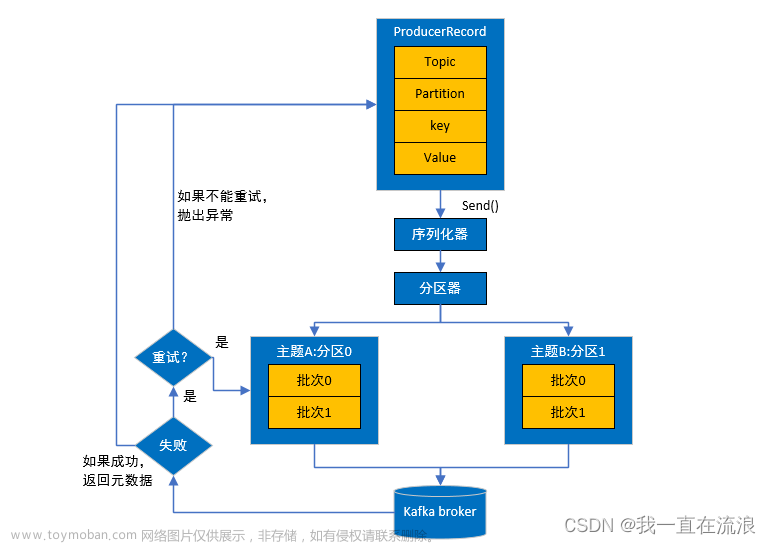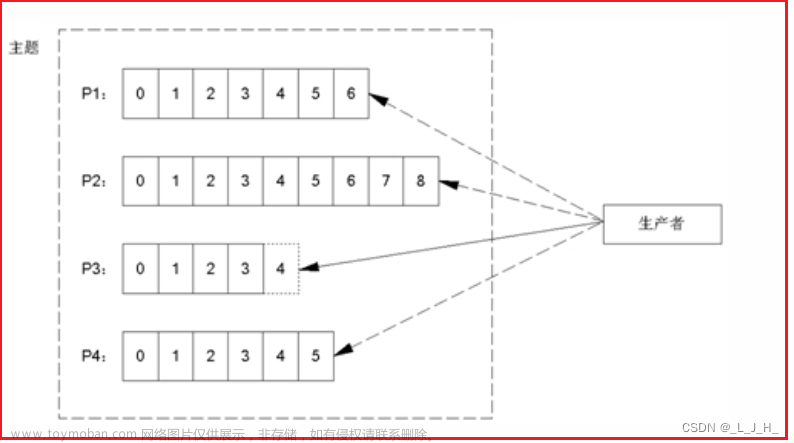kafka尚硅谷视频:
10_尚硅谷_Kafka_生产者_原理_哔哩哔哩_bilibili

1. producer初始化:加载默认配置,以及配置的参数,开启网络线程
2. 拦截器拦截
3. 序列化器进行消息key, value序列化
4. 进行分区
5. kafka broker集群 获取metaData
6. 消息缓存到RecordAccumulator收集器,分配到该分区的DQueue(RecordBatch)
7. batch.size满了,或者linker.ms到达指定时间,唤醒sender线程, 实例化networkClient
RecordBatch ==>RequestClient 发送消息体,
8. 与分区相同broker建立网络连接,发送到对应broker
1. send()方法参数producerRecord对象:

关于分区:

a.指定分区,则发送到该分区
b.不指定分区,k值没有传入,使用黏性分区(sticky partition)
第一次调用时随机生成一个整数(后面每次调用在这个整数上自增),将这个值与 topic 可用的 partition 总数取余得到 partition 值,也就是常说的 round-robin 算法
c.不指定分区,传入k值,k值先进行hash获取hashCodeValue, 再与topic下的分区数进行求模取余,进行分区。
如 k hash = 5 topic目前的分区数2 则 分区为:1
k hash =6 topic目前的分区数2 则 分区为:0
2. KafkaProducer 异步, 同步发送api:
异步发送:
producer.send(producerRecord对象);
同步发送则send()方法后面.get()
kafka 的send方法核心逻辑:
public Future<RecordMetadata> send(ProducerRecord<K, V> record) {
return this.send(record, (Callback)null);
}
public Future<RecordMetadata> send(ProducerRecord<K, V> record, Callback callback) {
// 拦截器集合。多个拦截对象循环遍历
ProducerRecord<K, V> interceptedRecord = this.interceptors.onSend(record);
return this.doSend(interceptedRecord, callback);
}
private Future<RecordMetadata> doSend(ProducerRecord<K, V> record, Callback callback) {
TopicPartition tp = null;
// 获取集群信息metadata
try {
this.throwIfProducerClosed();
long nowMs = this.time.milliseconds();
ClusterAndWaitTime clusterAndWaitTime;
try {
clusterAndWaitTime = this.waitOnMetadata(record.topic(), record.partition(), nowMs, this.maxBlockTimeMs);
} catch (KafkaException var22) {
if (this.metadata.isClosed()) {
throw new KafkaException("Producer closed while send in progress", var22);
}
throw var22;
}
nowMs += clusterAndWaitTime.waitedOnMetadataMs;
long remainingWaitMs = Math.max(0L, this.maxBlockTimeMs - clusterAndWaitTime.waitedOnMetadataMs);
Cluster cluster = clusterAndWaitTime.cluster;
// 序列化器 key序列化
byte[] serializedKey;
try {
serializedKey = this.keySerializer.serialize(record.topic(), record.headers(), record.key());
} catch (ClassCastException var21) {
throw new SerializationException("Can't convert key of class " + record.key().getClass().getName() + " to class " + this.producerConfig.getClass("key.serializer").getName() + " specified in key.serializer", var21);
}
// 序列化器 value序列化
byte[] serializedValue;
try {
serializedValue = this.valueSerializer.serialize(record.topic(), record.headers(), record.value());
} catch (ClassCastException var20) {
throw new SerializationException("Can't convert value of class " + record.value().getClass().getName() + " to class " + this.producerConfig.getClass("value.serializer").getName() + " specified in value.serializer", var20);
}
// 分区
int partition = this.partition(record, serializedKey, serializedValue, cluster);
tp = new TopicPartition(record.topic(), partition);
this.setReadOnly(record.headers());
Header[] headers = record.headers().toArray();
int serializedSize = AbstractRecords.estimateSizeInBytesUpperBound(this.apiVersions.maxUsableProduceMagic(), this.compressionType, serializedKey, serializedValue, headers);
this.ensureValidRecordSize(serializedSize);
long timestamp = record.timestamp() == null ? nowMs : record.timestamp();
if (this.log.isTraceEnabled()) {
this.log.trace("Attempting to append record {} with callback {} to topic {} partition {}", new Object[]{record, callback, record.topic(), partition});
}
Callback interceptCallback = new InterceptorCallback(callback, this.interceptors, tp);
// RecordAccumulator.append() 添加数据转 ProducerBatch
RecordAccumulator.RecordAppendResult result = this.accumulator.append(tp, timestamp, serializedKey, serializedValue, headers, interceptCallback, remainingWaitMs, true, nowMs);
if (result.abortForNewBatch) {
int prevPartition = partition;
this.partitioner.onNewBatch(record.topic(), cluster, partition);
partition = this.partition(record, serializedKey, serializedValue, cluster);
tp = new TopicPartition(record.topic(), partition);
if (this.log.isTraceEnabled()) {
this.log.trace("Retrying append due to new batch creation for topic {} partition {}. The old partition was {}", new Object[]{record.topic(), partition, prevPartition});
}
interceptCallback = new InterceptorCallback(callback, this.interceptors, tp);
result = this.accumulator.append(tp, timestamp, serializedKey, serializedValue, headers, interceptCallback, remainingWaitMs, false, nowMs);
}
if (this.transactionManager != null) {
this.transactionManager.maybeAddPartition(tp);
}
// 判断是否满了,满了唤醒sender , sender继承了runnable
if (result.batchIsFull || result.newBatchCreated) {
this.log.trace("Waking up the sender since topic {} partition {} is either full or getting a new batch", record.topic(), partition);
this.sender.wakeup();
}
return result.future;
} catch (ApiException var23) {
this.log.debug("Exception occurred during message send:", var23);
if (tp == null) {
tp = ProducerInterceptors.extractTopicPartition(record);
}
Callback interceptCallback = new InterceptorCallback(callback, this.interceptors, tp);
interceptCallback.onCompletion((RecordMetadata)null, var23);
this.errors.record();
this.interceptors.onSendError(record, tp, var23);
return new FutureFailure(var23);
} catch (InterruptedException var24) {
this.errors.record();
this.interceptors.onSendError(record, tp, var24);
throw new InterruptException(var24);
} catch (KafkaException var25) {
this.errors.record();
this.interceptors.onSendError(record, tp, var25);
throw var25;
} catch (Exception var26) {
this.interceptors.onSendError(record, tp, var26);
throw var26;
}
}
Sender类 run()方法:
public void run() {
this.log.debug("Starting Kafka producer I/O thread.");
while(this.running) {
try {
this.runOnce();
} catch (Exception var5) {
this.log.error("Uncaught error in kafka producer I/O thread: ", var5);
}
}
this.log.debug("Beginning shutdown of Kafka producer I/O thread, sending remaining records.");
while(!this.forceClose && (this.accumulator.hasUndrained() || this.client.inFlightRequestCount() > 0 || this.hasPendingTransactionalRequests())) {
try {
this.runOnce();
} catch (Exception var4) {
this.log.error("Uncaught error in kafka producer I/O thread: ", var4);
}
}
while(!this.forceClose && this.transactionManager != null && this.transactionManager.hasOngoingTransaction()) {
if (!this.transactionManager.isCompleting()) {
this.log.info("Aborting incomplete transaction due to shutdown");
this.transactionManager.beginAbort();
}
try {
this.runOnce();
} catch (Exception var3) {
this.log.error("Uncaught error in kafka producer I/O thread: ", var3);
}
}
if (this.forceClose) {
if (this.transactionManager != null) {
this.log.debug("Aborting incomplete transactional requests due to forced shutdown");
this.transactionManager.close();
}
this.log.debug("Aborting incomplete batches due to forced shutdown");
this.accumulator.abortIncompleteBatches();
}
try {
this.client.close();
} catch (Exception var2) {
this.log.error("Failed to close network client", var2);
}
this.log.debug("Shutdown of Kafka producer I/O thread has completed.");
}
void runOnce() {
if (this.transactionManager != null) {
try {
this.transactionManager.maybeResolveSequences();
if (this.transactionManager.hasFatalError()) {
RuntimeException lastError = this.transactionManager.lastError();
if (lastError != null) {
this.maybeAbortBatches(lastError);
}
this.client.poll(this.retryBackoffMs, this.time.milliseconds());
return;
}
this.transactionManager.bumpIdempotentEpochAndResetIdIfNeeded();
if (this.maybeSendAndPollTransactionalRequest()) {
return;
}
} catch (AuthenticationException var5) {
this.log.trace("Authentication exception while processing transactional request", var5);
this.transactionManager.authenticationFailed(var5);
}
}
long currentTimeMs = this.time.milliseconds();
// 发送数据
long pollTimeout = this.sendProducerData(currentTimeMs);
this.client.poll(pollTimeout, currentTimeMs);
}sendProducerData() :
最终转换为ClientRequest对象
ClientRequest clientRequest = this.client.newClientRequest(nodeId, requestBuilder, now, acks != 0, this.requestTimeoutMs, callback); this.client.send(clientRequest, now);
private long sendProducerData(long now) {
Cluster cluster = this.metadata.fetch();
RecordAccumulator.ReadyCheckResult result = this.accumulator.ready(cluster, now);
Iterator iter;
if (!result.unknownLeaderTopics.isEmpty()) {
iter = result.unknownLeaderTopics.iterator();
while(iter.hasNext()) {
String topic = (String)iter.next();
this.metadata.add(topic, now);
}
this.log.debug("Requesting metadata update due to unknown leader topics from the batched records: {}", result.unknownLeaderTopics);
this.metadata.requestUpdate();
}
iter = result.readyNodes.iterator();
long notReadyTimeout = Long.MAX_VALUE;
while(iter.hasNext()) {
Node node = (Node)iter.next();
if (!this.client.ready(node, now)) {
iter.remove();
notReadyTimeout = Math.min(notReadyTimeout, this.client.pollDelayMs(node, now));
}
}
Map<Integer, List<ProducerBatch>> batches = this.accumulator.drain(cluster, result.readyNodes, this.maxRequestSize, now);
this.addToInflightBatches(batches);
List expiredBatches;
Iterator var11;
ProducerBatch expiredBatch;
if (this.guaranteeMessageOrder) {
Iterator var9 = batches.values().iterator();
while(var9.hasNext()) {
expiredBatches = (List)var9.next();
var11 = expiredBatches.iterator();
while(var11.hasNext()) {
expiredBatch = (ProducerBatch)var11.next();
this.accumulator.mutePartition(expiredBatch.topicPartition);
}
}
}
this.accumulator.resetNextBatchExpiryTime();
List<ProducerBatch> expiredInflightBatches = this.getExpiredInflightBatches(now);
expiredBatches = this.accumulator.expiredBatches(now);
expiredBatches.addAll(expiredInflightBatches);
if (!expiredBatches.isEmpty()) {
this.log.trace("Expired {} batches in accumulator", expiredBatches.size());
}
var11 = expiredBatches.iterator();
while(var11.hasNext()) {
expiredBatch = (ProducerBatch)var11.next();
String errorMessage = "Expiring " + expiredBatch.recordCount + " record(s) for " + expiredBatch.topicPartition + ":" + (now - expiredBatch.createdMs) + " ms has passed since batch creation";
this.failBatch(expiredBatch, (RuntimeException)(new TimeoutException(errorMessage)), false);
if (this.transactionManager != null && expiredBatch.inRetry()) {
this.transactionManager.markSequenceUnresolved(expiredBatch);
}
}
this.sensors.updateProduceRequestMetrics(batches);
long pollTimeout = Math.min(result.nextReadyCheckDelayMs, notReadyTimeout);
pollTimeout = Math.min(pollTimeout, this.accumulator.nextExpiryTimeMs() - now);
pollTimeout = Math.max(pollTimeout, 0L);
if (!result.readyNodes.isEmpty()) {
this.log.trace("Nodes with data ready to send: {}", result.readyNodes);
pollTimeout = 0L;
}
this.sendProduceRequests(batches, now);
return pollTimeout;
}
private void sendProduceRequests(Map<Integer, List<ProducerBatch>> collated, long now) {
Iterator var4 = collated.entrySet().iterator();
while(var4.hasNext()) {
Map.Entry<Integer, List<ProducerBatch>> entry = (Map.Entry)var4.next();
this.sendProduceRequest(now, (Integer)entry.getKey(), this.acks, this.requestTimeoutMs, (List)entry.getValue());
}
}
private void sendProduceRequest(long now, int destination, short acks, int timeout, List<ProducerBatch> batches) {
if (!batches.isEmpty()) {
Map<TopicPartition, ProducerBatch> recordsByPartition = new HashMap(batches.size());
byte minUsedMagic = this.apiVersions.maxUsableProduceMagic();
Iterator var9 = batches.iterator();
while(var9.hasNext()) {
ProducerBatch batch = (ProducerBatch)var9.next();
if (batch.magic() < minUsedMagic) {
minUsedMagic = batch.magic();
}
}
ProduceRequestData.TopicProduceDataCollection tpd = new ProduceRequestData.TopicProduceDataCollection();
Iterator var16 = batches.iterator();
while(var16.hasNext()) {
ProducerBatch batch = (ProducerBatch)var16.next();
TopicPartition tp = batch.topicPartition;
MemoryRecords records = batch.records();
if (!records.hasMatchingMagic(minUsedMagic)) {
records = (MemoryRecords)batch.records().downConvert(minUsedMagic, 0L, this.time).records();
}
ProduceRequestData.TopicProduceData tpData = tpd.find(tp.topic());
if (tpData == null) {
tpData = (new ProduceRequestData.TopicProduceData()).setName(tp.topic());
tpd.add(tpData);
}
tpData.partitionData().add((new ProduceRequestData.PartitionProduceData()).setIndex(tp.partition()).setRecords(records));
recordsByPartition.put(tp, batch);
}
String transactionalId = null;
if (this.transactionManager != null && this.transactionManager.isTransactional()) {
transactionalId = this.transactionManager.transactionalId();
}
ProduceRequest.Builder requestBuilder = ProduceRequest.forMagic(minUsedMagic, (new ProduceRequestData()).setAcks(acks).setTimeoutMs(timeout).setTransactionalId(transactionalId).setTopicData(tpd));
RequestCompletionHandler callback = (response) -> {
this.handleProduceResponse(response, recordsByPartition, this.time.milliseconds());
};
String nodeId = Integer.toString(destination);
ClientRequest clientRequest = this.client.newClientRequest(nodeId, requestBuilder, now, acks != 0, this.requestTimeoutMs, callback);
// this.client 为KafkaClient接口 实现类:NetworkClient对象
this.client.send(clientRequest, now);
this.log.trace("Sent produce request to {}: {}", nodeId, requestBuilder);
}
}NetworkClient send()方法:
public void send(ClientRequest request, long now) {
this.doSend(request, false, now);
}
private void doSend(ClientRequest clientRequest, boolean isInternalRequest, long now) {
this.ensureActive();
String nodeId = clientRequest.destination();
if (!isInternalRequest && !this.canSendRequest(nodeId, now)) {
throw new IllegalStateException("Attempt to send a request to node " + nodeId + " which is not ready.");
} else {
AbstractRequest.Builder<?> builder = clientRequest.requestBuilder();
try {
NodeApiVersions versionInfo = this.apiVersions.get(nodeId);
short version;
if (versionInfo == null) {
version = builder.latestAllowedVersion();
if (this.discoverBrokerVersions && this.log.isTraceEnabled()) {
this.log.trace("No version information found when sending {} with correlation id {} to node {}. Assuming version {}.", new Object[]{clientRequest.apiKey(), clientRequest.correlationId(), nodeId, version});
}
} else {
version = versionInfo.latestUsableVersion(clientRequest.apiKey(), builder.oldestAllowedVersion(), builder.latestAllowedVersion());
}
this.doSend(clientRequest, isInternalRequest, now, builder.build(version));
} catch (UnsupportedVersionException var9) {
this.log.debug("Version mismatch when attempting to send {} with correlation id {} to {}", new Object[]{builder, clientRequest.correlationId(), clientRequest.destination(), var9});
ClientResponse clientResponse = new ClientResponse(clientRequest.makeHeader(builder.latestAllowedVersion()), clientRequest.callback(), clientRequest.destination(), now, now, false, var9, (AuthenticationException)null, (AbstractResponse)null);
if (!isInternalRequest) {
this.abortedSends.add(clientResponse);
} else if (clientRequest.apiKey() == ApiKeys.METADATA) {
this.metadataUpdater.handleFailedRequest(now, Optional.of(var9));
}
}
}
}
private void doSend(ClientRequest clientRequest, boolean isInternalRequest, long now, AbstractRequest request) {
String destination = clientRequest.destination();
RequestHeader header = clientRequest.makeHeader(request.version());
if (this.log.isDebugEnabled()) {
this.log.debug("Sending {} request with header {} and timeout {} to node {}: {}", new Object[]{clientRequest.apiKey(), header, clientRequest.requestTimeoutMs(), destination, request});
}
Send send = request.toSend(header);
// clientRequest convert InFlightRequest 对象
InFlightRequest inFlightRequest = new InFlightRequest(clientRequest, header, isInternalRequest, request, send, now);
this.inFlightRequests.add(inFlightRequest);
// nio channel。。。selector 发送消息信息
//this.selector is Selectable interface KafkaChannel is implement
this.selector.send(new NetworkSend(clientRequest.destination(), send));
}总结:直接阅读源码很快就能想明白kafka 生产者发送逻辑,kafka-client.jar。 核心==>
本文第一张图片文章来源:https://www.toymoban.com/news/detail-672545.html
 文章来源地址https://www.toymoban.com/news/detail-672545.html
文章来源地址https://www.toymoban.com/news/detail-672545.html
到了这里,关于Kafka生产者原理 kafka生产者发送流程 kafka消息发送到集群步骤 kafka如何发送消息 kafka详解的文章就介绍完了。如果您还想了解更多内容,请在右上角搜索TOY模板网以前的文章或继续浏览下面的相关文章,希望大家以后多多支持TOY模板网!









